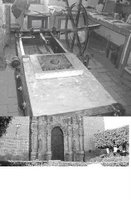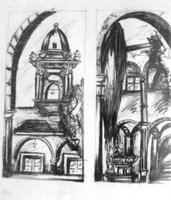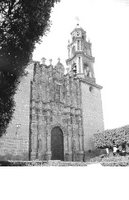2006 April: Rebecca Benoit (Lithographs)


 EXILE
EXILEStepping Stones Art Gallery:
April 22- 30, 2006
14 lithographs by Rebecca Benoit in 1995
Choosing Exile:
Exhibit Statement
San Miguel de Allende (SMA) has been a haven for North American artists since the 1950s. This UNESCO World Heritage town in the high Mexican desert supports a population of 100,000 (of which over 5,000 are expatriates). I joined this community over the winter of 1995 in order to explore art and culture. Over the 6 months that I lived in San Miguel, I worked on the series of 14 lithographs presented in this exhibit.
My days in San Miguel were truly magical: I awoke in the early morning and spent hours boiling water for the day’s tea (the high altitude affected everything from my appetite to the time it took to boil water).
Walking down the cobble-stoned roads, I would arrive at the Bellas Artes School around 9:00 in order to secure the best piano room. There, I’d practice for 2 – 3 hours before returning home for siesta in the afternoon. During siesta, the whole town relaxed and ate before preparing for the evening while I wrote in my journal and sketched.
Lithography discovered
In the evenings, there were art openings, concerts, play-readings and dinners to attend, in addition to a myriad of art courses offered at many schools. Most of San Miguel’s residents sample month-long classes before settling on a style that suits them. Long-interested in drawing, another artist recommended that I explore lithographic printmaking.
Bellas Artes
I was very fortunate that the Bellas Artes offered a lithography class with Profesora Margarita Orozxo Ramirez, niece of the famous Mexican Muralist, Jose Orozco. Margarita was a patient teacher, insisting that we speak only Spanish in class and do numerous sketches before drawing directly on the stone.
Over the months I worked in Margarita’s studio, a theme of exile began to emerge in my drawings. My Mexican, Greek and French classmates wondered what my art was trying to communicate; why this Canadian girl, far from home, was so concerned with her identity and nation.
Bellas Artes is an ex-convent built in over 400 years ago which attracts visitors from all over the world to study dance, music, painting and weaving. Tel: 152-0289
Three Artistic Themes
During 1995, for those who remember, there was a very close call with the Referendum in Quebec. This theme is evident in three of the lithographs (Barca, Por Favor and Single Snowflake). The feeling of being alone, and surviving the cold days (though we often think of Mexico as hot) is evidenced in my preoccupation with tea images.
Later, once I had adjusted to longing for my culture, and adapted to the climate of the one I found myself in, my artwork began to explore my new environment in the landscape (the architectural studies of the state of Guanahuato, the beach scene, the trees of the central Jardin etc.). Finally, the time came when I was ready to reflect on the emotional experience of choosing exile and the last two pieces, ‘If only you could hear me from here’ and ‘SMA compilation’.
From Stone to Paper
The process of creating a print from start to finish I soon learned was a very time-consuming task. There is no room for error : once you begin to draw, it is impossible to erase without grinding the stone and starting over from the beginning. Thus, after printing, I sometimes felt as though I should have spent longer on a drawing – or thought through a design a little more before committing the idea to stone.
This is the first time this collection of prints has been exhibited together. I hope you enjoy the playful spirit I’ve tried to capture on my experience of living ‘Away’.
For more information on San Miguel: http://www.sanmiguelguide.com/
or http://www.portalsanmiguel.com/
Artist Biography: Rebecca Benoit
Rebecca first studied drawing and lithography for six months in San Miguel de Allende, Mexico. She now enjoys painting something far less time-consuming: the simplicity of black and white Japanese brush paintings
Contact Rebecca at: beccabenoit[at]yahoo.com
Interested in Lithography?
Ottawa School of Art offers courses in lithography in the fall. Contact them at: http://www.artottawa.ca/
Or call 241-7471
Lithography: What is it exactly?
Lithography was invented by Alois Senefelder in Germany in 1798 and, within twenty years, appeared in England and the United States. The basic process is for an artist to draw (using waxy, crayon-like pencils) onto a polished limestone surface, which is then chemically prepared and inked for printing.
Everything is reversed in lithography, a principle I learned the hard way with my first work ‘Tren’. I had wanted the train to move upwards to the right, indicating the struggle, but energy and excitement I felt being in a new country and facing an uncertain future.
Unfortunately, I was over-eager in my drawing and Margarita and classmates hadn’t yet explained I should draw everything backwards (mirrors later became very useful).
For the full text of Senefelder’s book explaining the invention and process of lithography see: http://fax.libs.uga.edu/NE2420xS475/1f/invention_of_lithography.txt.
The Lithographic Process: Time
Preparing, sanding the limestone (Removing about 0.5 mm of the stone): 3-5 hrs.
Designing the image: This depends on the artist – some spend minutes – others do multiple sketches on paper before committing their design to stone because once you draw on the prepared stone – you cannot erase or correct anything!
PROCESS
Drawing the image (no erasing!): 2-3 hrs.
Gum Arabic & Nitric Acid coat which creates a layer around image; seeps into stone: 2 – 3 days
Washing stone with water for printing: 2 hrs.
Preparing the Ink, stone and roller: 1 hr.
Printing (12 – 24 prints): 2 – 4 hrs.
Hanging the print to dry: 24 hrs.
TOTAL TIME (minus creative process): 1-3 weeks

<< Home